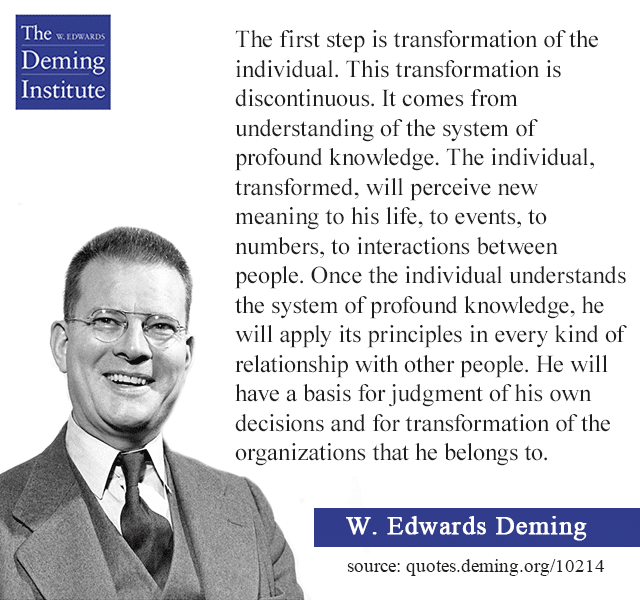By John Hunter, founder of CuriousCat.com.
In response to our request asking what topics readers would like to see addressed on our blog, Dan Bracewell said:
I’d like to see some posts about how to implement change in an organization. How does one get an organization to start looking at itself as a system? How does one get the organization to realize that the most important figures are unknown and unknowable? How does one convince an organization the importance of driving out fear? In short, how does one get an organization to listen to what Deming had to say?
I don’t think there are simple answers to the questions that take the form of “do this simple thing and you will have the results you wish to see.” This makes “selling” organizations on the idea of adopting the Deming management system more challenging. But I think it is a fundamental aspect of a good management system that cannot be avoided. Simplistic “solutions” may be easier to sell, but they don’t work. Managing an organization well just doesn’t allow for recipe solutions.
There are principles that can be fairly easily captured (respect people, improve using iterative experiments, use data to learn and test your understanding when possible but also realize that using data is not always possible…) but thought is still required to apply them within your organization.
As W. Edwards Deming said in The New Economics
That does not offer a simple recipe laying out what steps to take. But I do think it is a good explanation of the process. What should be implemented in your organization and what specific steps to take are not obvious, it requires applying the principles to your organization. And doing that requires building the capability of your organization (including your people) to operate using those principles.
You need to work with what you can and gain credibility with successes. Doing so will make others more and more willing to listen to you.
Making progress related to the individual questions Dan asked is a cumulative effort: as progress on any one is made, making progress on the others becomes easier. As people see the organization as a system they can more easily appreciate the importance of things that are unmeasurable (and visa versa) etc..
I have written about the ideas raised in the questions on my Curious Cat Management blog and on this blog: Habits, What to Do To Create a Continual Improvement Culture and How to Start Applying Deming’s Ideas on Management.
My basic belief is that the way to succeed along these lines is to help people improve and while doing so explain how what is done relates to the points you mention (fear caused the problem we had to fix etc.). Few believe you at first. After you help numerous times more people start to believe maybe the overall philosophy actually is worth listening to since you seem to be able to make things better and you keep tying it back to view the organization as a system, understanding variation (and what data can and cannot tell you…), etc..
As I wrote before on this blog: people take time to believe claims of changed management practices. Adopting a Deming management system is an iterative process. As you make progress you enable more progress to be made that would have been extremely difficult or unlikely to make prior to those previous changes. And you learn from current efforts what works well in your organization and what doesn’t work (at least as the organization is currently functioning). From that learning you can devise new experiments and use PDSA to tune the efforts (or learn that it is wise to abandon those attempts and try something else).
The transformation process is a never ending focus on continual improvement.
Related: Communicating Change – Start small, with projects people actually care about – Change has to Start from the Top (and you are the top of something): Webcast with David Langford – Culture Change Requires That Leaders Change Their Behavior




Hi Deming Institute,
I had recently tried to change the system in my previous tech company unsuccessfully. In the tech world, we tend to do things quick and take many shortcuts. But as we’re moving towards a micro service heavy system where each team relies on each other, I realized that we’ve been doing things wrong. The concept of solving problems upstream is foreign and most teams are doing the same work across each team as a result. When we’re not solving problems upstream, we’re spreading the same work among individual teams when we could have just done the work once together. I’m looking to meet with people here and share any insights and learning experiences I’ve had at my attempt for changing the system with Total Quality Management and continue to learn from others.
Best,
James Zhang
Hi Deming Institute,
I had recently tried to change the system in my previous tech company unsuccessfully. In the tech world, we tend to do things quick and take many shortcuts. But as we’re moving towards a micro service heavy system where each team relies on each other, I realized that we’ve been doing things wrong. The concept of solving problems upstream is foreign and most teams are doing the same work across each team as a result. When we’re not solving problems upstream, we’re spreading the same work among individual teams when we could have just done the work once together. I’m looking to meet with people here and share any insights and learning experiences I’ve had at my attempt for changing the system with Total Quality Management and continue to learn from others.
Best,
James Zhang